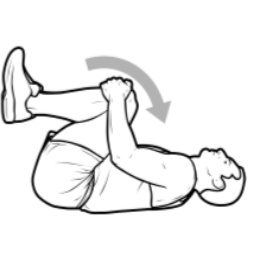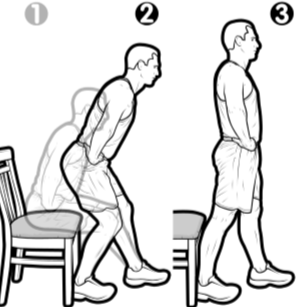How to relieve acute low back pain (at least until you can see us!)
 We see a lot of people with acute low back pain in our clinic, in fact low back pain is the most common reason to visit an osteopath. We have a strong success rate with relieving the symptoms of acute low back pain, but the relief is not always instantaneous, often there are a few days either leading up to getting an appointment with us or there are a few days after treatment where the low back is still inflamed and sore. So how do you cope in this period where the pain can be quite intense but you still need to be able to function day to day? To help answer this we have put together a few hints and tips to help people be as comfortable as possible during what can be a rather painful time. (Please note that these tips are not intended as a diagnosis or advice for a specific condition, they are general in nature. If you are worried about your pain or have extreme symptoms then please either contact us to arrange a consultation or visit your GP/call 111).
We see a lot of people with acute low back pain in our clinic, in fact low back pain is the most common reason to visit an osteopath. We have a strong success rate with relieving the symptoms of acute low back pain, but the relief is not always instantaneous, often there are a few days either leading up to getting an appointment with us or there are a few days after treatment where the low back is still inflamed and sore. So how do you cope in this period where the pain can be quite intense but you still need to be able to function day to day? To help answer this we have put together a few hints and tips to help people be as comfortable as possible during what can be a rather painful time. (Please note that these tips are not intended as a diagnosis or advice for a specific condition, they are general in nature. If you are worried about your pain or have extreme symptoms then please either contact us to arrange a consultation or visit your GP/call 111).
Painkillers!
Osteopaths are commonly thought to be against the use of painkillers, however we are most certainly not! Medical technology has given us the tools (and pills) to help control pain, and while long term use of painkillers is not recommended for the treatment of low back pain there is absolutely no shame in taking a painkiller (advised by your pharmacist or doctor) while the pain is severe and acute. Not only will you feel less pain but you will also begin to normalise your movements and habits which can help in the short term to begin to resolve the problem.
Knee hugs (and getting out of bed)
These are a great little exercise to help get some movement and relief in an low back that is sore and ‘locked up’. We often get people with acute low back pain to do these before they try to get out of bed in the morning as the inflammation and stiffness associated with acute pain can often be at it’s worst on waking. You lie on your back, bring your knees up towards your chest and perform small pulsing actions of bringing the knees closer to your chest (if you can’t get the knees up to the chest ten place a towel under the knees and use this to reduce the amount you have to flex up), this helps give a little bit of stretch in the low back joints and muscles meaning that when you go to get up then there is (hopefully) a little bit more pain free movement to work with. Then when you go to get up, lie on your side close to and facing the edge of the bed, with one movement drop your lower legs off the side of the bed and push yourself up to sitting with your hands (this will help reduce some of the movements that can worsen low back pain).
Ice/cold pack
Ice is great for reducing pain in acute situations, this is mainly due to the effect of the cold causing the local blood vessels to constrict and reducing the flow of pain sensitizing chemicals to the area, see here for a more in-depth article on how heat or ice can help with pain. Simple methods such as using ice cubes or frozen peas wrapped in a barrier such as a tea towel are fine, up to 15 mins at a time. As a vague rule, when you’re numb you’re done.
If the above tips don’t give you much relief then you may find moving around and performing basic tasks hard to do without pain, but there are f few things you can do to help normal life become a bit easier.
Getting out of the car
 This is one action we hear about causing difficulty for people with acute low back pain. There is no perfect way to do this but what can help is before you get into the car place a plastic bag on the seat, then when you go to get out you can rotate on the seat and get both legs out of the car onto the ground before you stand up. This removes the need to rotate the low back which can often be painful.
This is one action we hear about causing difficulty for people with acute low back pain. There is no perfect way to do this but what can help is before you get into the car place a plastic bag on the seat, then when you go to get out you can rotate on the seat and get both legs out of the car onto the ground before you stand up. This removes the need to rotate the low back which can often be painful.
Getting up from sitting
Often people find that sitting can relieve acute low back pain, but that getting up from the chair can be quite difficult, and the lower the chair the worse it can be (getting up from the toilet can be a similar challenge). Usually this is an issue as people load the structures of the back excessively in the motion of getting up to standing. One way to reduce the strain is to ‘split your stance’, and to place your feet more underneath you before you try to get up, this place more load on the leg and thigh muscles and allows you more control over how you move to avoid aggravating your back.
Leaning forwards
Once you are standing up.,one of the most common positions that causes pain is standing up, and slightly bent forwards. This is a movement we all do on a daily basis, when we wash up, brush our teeth, iron etc but you probably never notice it…..until you are unfortunate enough to have some low back pain. Two ways you can help to get these tasks done with a bit more ease is to slightly bend your knees before you try to bend forwards, or to place one foot on a small step/box (you may need to try putting either foot up), if you are standing at a sink then open the cupboard and place one foot on the lip of the shelf. Why this works is not completely clear but it may help reduce all the load of the movement being placed on the low back and transfer it to the hips and knees.
Acute low back pain is bit like toothache, nobody wants it, it can be sorted out quickly in the majority of cases, but there is usually a few days where the pain can be intrusive. We hope the above guide helps make those few days of discomfort before you are able to get to see us to diagnose your pain and begin treatment easier to deal with. You can find lots of information and advice on different conditions in our resources section.
Do you want to know what is causing your pain and if we can help? Why not take advantage of our new patient assessment introductory offer to get you started towards a tailor made recovery plan for only £19.
Are you in a lot of pain and want to get better as soon as possible? If so then why not book in for a new patient consultation, with treatment on the day, for £75.
